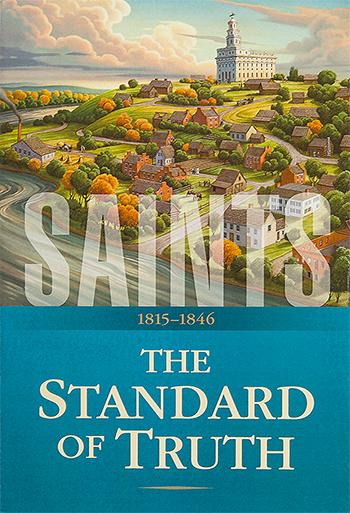6 Reasons Why You Should Read the New Church History Book, Saints
Contributed By Marianne Holman Prescott, Church News staff writer

Steven C. Harper, Church historian and a writer of the Church’s new history, Saints, answers the question “Why do Church members today need Saints?”
“This story is not about perfect people; it is about fallen people who are trying to become saints through the Savior’s Atonement by making and keeping covenants.” —Steven C. Harper, Church historian
Related Links
In 1993, as a young married student studying in Nauvoo, Illinois, Steven C. Harper woke up in a hospital bed with no recollection of who he was, where he was, or how he got there.
Doctors peppered him with questions, asking what his name was and if he could identify where he was from.
“That happened to me,” Harper recalled during a BYU Education Week presentation. “In 1993 I was on a semester travel study with my wife, Jennifer, in Nauvoo, and I woke up in the university hospital at the University of Iowa. I did not know who I was, who she was, or that we were expecting a baby.”
He had an infection in the tissue around his brain, and no one knew whether he would ever know who he was again.
“Thankfully, I was healed in my memory,” Harper said.
Since that time, the Church historian has thought a lot about memory.
“A person without memory/history is unaware of who they are, where they came from, and where they’re going,” Harper said. “A person without memory/history does not know how they relate to God.”
Harper, who is one of the writers of the Church’s new history, Saints, likened his experience to Church members knowing their past and shared six reasons why “Saints need Saints.”

Cover of the first volume of Saints.

The first volume in the new history of the Church series, titled The Standard of Truth, is now available in 14 languages digitally and in print in English. Print editions in other languages will follow before the end of the year.
1. “We aren’t Latter-day Saints if we don’t remember what makes us Latter-day Saints.”
There is a link between knowing “who we are” and “whose we are,” he said. People without memory are unaware of who they are and where they came from. Without that understanding, knowledge of the greater plan of salvation is incomplete.
2. “Past histories aren’t helping us remember our story.”
Past Church histories are really good for what they are and when they were composed, Harper said.
This new history is meant for Church members today, to help them with present-day problems.
“One way to think of Saints is as a collective memory of all Latter-day Saints, the knowledge that we share or will share in common that makes us one and gives us our existence as a group,” he said.
He called it a “happy marriage between accurate history and narrative storytelling.”
3. “Our story teaches us who we are and whose we are. It shows us how we fit in God’s plan for our salvation and happiness.”
The four-volume history tells the history of the Church through the stories of its members. Rather than a comprehensive history of the institutional Church, the narrative walks readers through the lives of Saints.
“From the very beginning there was an inspired vision for this project,” said Harper. “It would be inclusive, it would be creative, and be transparent and powerful, be sacred and truthful and edifying and fortifying, and good in every sense.”
4. To correct two false ideas: that God worked only through ultra righteous people in the past, and if Joseph Smith, Brigham Young, and others were flawed God couldn’t have worked through them.
“Characters beginning with Joseph Smith and his family are flawed because the natural man is an enemy of God,” Harper said. “This story is not about perfect people; it is about fallen people who are trying to become saints through the Savior’s Atonement by making and keeping covenants.”
Although the history isn’t able to include every single member of the Church in the narrative, it is a sample of compelling, sacred stories that are analogous to one’s own sacred quest to become a saint.
“The story depends on the choices the characters make; their choices create the drama and suspense that is inherent in history and in great storytelling,” Harper said. “The story is global and universal. It concerns all people everywhere, throughout time and space.”
5. Saints teaches a reader to interpret the facts of history with faith, hope, and charity.
By looking at the imperfect experiences of the characters in Saints, readers are able to see how their forebearers—despite opposition or even a poor decision—were still loved by the Lord and able to draw upon the Atonement of Jesus Christ to change.
6. Saints helps readers safely through the gap between naïve faith and informed mature faith.
“We begin with the kind of naïve faith—the childlike faith—in an ideal world where prophets and pioneers and parents are perfect,” said Harper.
But that naïve faith will not withstand the rigors and forces of the real world if members do not mature in their faith.
“Some people choose to fill the gap between naïve faith and mature faith with cynicism,” Harper said. “In the gap, we discovered that some of our naïve assumptions are not true. We run up against facts of history that cause us to rethink assumptions of our naïve faith. In the gap we have choices to make: Do I still believe what it is that I believe?”
Some people decide, Harper explained, that because the facts are not what they assumed they should be, they can’t believe anymore.
“However, as I and many other people have experienced personally, we can mature past cynicism to informed faith,” he said. “We can make it safely through the gap. Saints is very intentionally designed to help people safely bridge the gap that they must pass from naïve faith to informed faith.”
With an understanding that the people and the Church are “not perfect—far from it,” Saints helps readers understand that the Church is a great laboratory for perfecting Saints.
